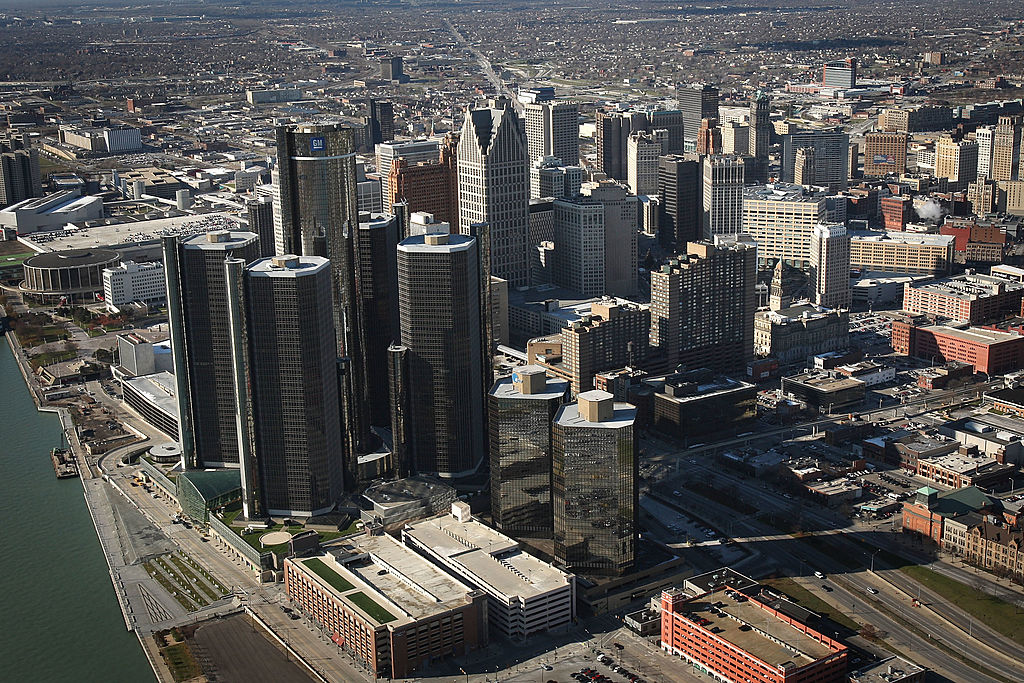Detroit, Michigan
A cowboy’s work is never done, as Sonny Bono once croaked. (I interviewed Sonny shortly after he was elected to Congress in the Republican wave of 1994. He confirmed to me that Cher thought that the faces on Mount Rushmore were a natural formation.)
Segueing from one Armenian American to another: when I lured my wife from the Chandleresque precincts of Southern California to the Edenic plains of New York’s Burned-Over District (“married an LA doll and brought her to this small town,” as John Mellencamp growled), she asked to visit two cities: Utica and Cleveland.
Having made her dreams come true, as is my wont, I thought my work was done. But no. This summer we took a side trip to Sonny Bono’s hometown of Detroit en route to a friend’s fiftieth birthday party in Warsaw, Indiana, hometown of the ponderous naturalist-communist novelist Theodore Dreiser. In preparation, I resolved for the umpteenth time to read An American Tragedy, Dreiser’s 800-page-plus fictionalization of the 1906 drowning of Grace Brown in Big Moose Lake. But for the umpteenth time I got lost in what even his admirer H.L. Mencken called Dreiser’s “laborious, cheerless way.”
In Detroit, we saw but could not enter the Mariners’ Church, which was retitled “the maritime sailors’ cathedral” by Gordon Lightfoot in “The Wreck of the Edmund Fitzgerald.” This Anglican church is where the great poet-singer Patti Smith and her husband, Fred “Sonic” Smith, sometimes worshipped. I played Smith’s “Frederick” in anticipation.
Ideological feminists have never known quite what to make of Patti Smith, who is in the great reactionary/radical Beat tradition. Listen to her explanation of why she took a lengthy break from performing to care for her dying husband in suburban Detroit:
I don’t mind being called a housewife, though I didn’t disappear to be a housewife. I disappeared to be by the side of the man that I loved. It was a sometimes difficult but always honorable position, and I think nothing greater could have happened to me at that time. I learned a lot of things in that process: humility, respect for others. We had two beautiful children, and I developed my skills and hopefully developed into the clean human being that I was as a child.
“There’s no job harder than being a wife and a mother,” she said. “It’s a position that should be respected and honored, not looked upon as some sappy alternative. It’s much more demanding and required much more nobility than the other work that I did.”
On Detroit’s outskirts, the Arab restaurants of Dearborn did not disappoint. We also dropped by Ann Arbor to pay our disrespects to the University of Michigan’s football team. My wife, a college gridiron fan, is a USC graduate and our daughter went to Notre Dame, so Wolverines coach Jim Harbaugh ranks somewhere between Atatürk and UCLA in Lucine’s estimation.
On a more soulful note, we greatly enjoyed the Motown Museum on Detroit’s West Grand Boulevard, where Berry Gordy & Co. created luminous pop music in the 1960s. Particularly charming was the old candy machine, stocked with the creamy, nougaty staples of our youth.
A smattering of dimes sits atop the machine. Ten-cent pieces always occupied that spot, a favor to young Stevie Wonder. The blind musician would pick up a coin, drop it in the slot, and pull the fourth handle from the right to get his favorite, a Baby Ruth bar. Places where the blind meet the sighted interest me. Since 1868, my hometown of Batavia has been graced by the New York State School for the Blind, which occupies a curious spot in our town: in it but not always of it; a significant employer but a shadowy presence.
Before the recent mainstreaming of blind students in public education, sightless boys and girls regularly walked our neighborhood streets, sticks tapping the sidewalk to guide their passage. The school’s wrestling team used to grapple against local squads.
Since childhood I have roamed the grounds of the Blind School in autumn, picking up chestnuts from the ground, dehiscing them and giving the nuts to my mother, who puts them in clothes pockets to ward off moths. But really that’s just an excuse for me to indulge a favorite activity of youth.
Across the street from the Blind School stands Centennial Park, whose maple and cherry trees are resplendent every fall. In fact, I’m writing this as I sit on a park bench, leaves of orange and russet and flame carrying me back.
The supreme irony of our town is that the best view is from the Blind School. Make of that what you will.
This article was originally published in The Spectator’s December 2022 World edition.

























